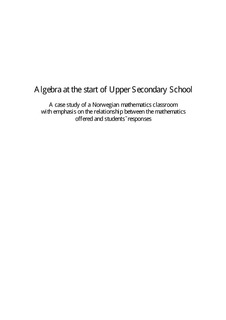| dc.description.abstract | Norwegian students at the end of lower secondary school are according to international comparative studies weak in algebra. This thesis reports a study of a mathematics classroom at the start of upper secondary school, when basic algebra, number, and number operations are recapitulated. One aim has been to study what kind of mathematics is emphasised. The analysis is done on the basis of the textbook, the tasks, and the presentation in the classroom. Another aim has been to inquire into what experiences students have of the mathematics offered in the classroom. Experiences are not directly accessible, but the analyses are based on students’ oral and written responses in the classroom and in interviews, and on all their written task solutions. A third aim appeared during the work with the data, and was to explore how the setting of the mathematics classroom influences students’ experiences. The study, combines the social and the individual perspective, and is based on a conceptual framework with concepts from different theories and studies. Important concepts reflecting the individual perspective are, ‘concept image’, ‘proceptual thinking’, ‘structure sense’, and ‘mathematical proficiency’. The social perspective is reflected by some concepts from social interactionism, the ‘didactical contract’ from the theory of didactical situation, and ‘task discourse’. The data were of different kinds and from different sources: classroom observations, interviews with students and the teacher, written material from students’ task solutions; both tests and assigned tasks, teacher’s explanation, and the textbook with its resources. The analyses revealed that the mathematics offered was focused on rules and algorithms, with little or no connection to the underlying concepts. The textbook tasks were of a low level of cognitive demand and did not challenge students to develop their concept images. Important concepts and principles were not explicitly addressed; a request for developing conceptual understanding. The teacher addressed some issues. Students’ responses revealed that problems reported in former studies still exist. The problems are well-known, but the textbook seems not to have been based on research within the area of mathematics education, and thus gave no adequate attention to help those students who struggled to overcome these problems. The didactical contract, the task discourse, the pressure on curriculum time, and the inadequate teaching material seemed to constrain students in developing conceptual understanding and thus procedural fluency. | |
